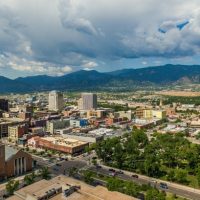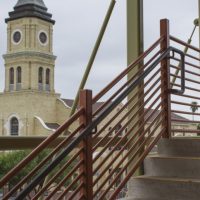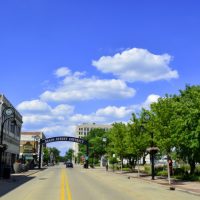The city of Sandy Springs is a popular suburban location in Northern Fulton County, just outside of the bustling city of Atlanta.
Sandy Springs has become a haven for homebuyers seeking easy access to Atlanta amenities while enjoying a somewhat autonomous lifestyle.
This guide talks about some of the pros and cons of living in Sandy Springs.
Contents
Pros of Living in Sandy Springs, GA
1. Proximity to Atlanta
Many Sandy Springs residents choose to live in the area because of its proximity to one of the south’s most prominent major metropolitan areas.
Residents can find job opportunities in nearby Atlanta and other surrounding suburbs.
They can also easily access popular entertainment venues and cultural attractions, including museums, theaters, and downtown Atlanta.
Students living in Sandy Springs can find a wealth of top-notch educational opportunities, as Atlanta is home to several top universities and colleges.
2. Good School District
Parents with school-aged and college-bound kids rave about the school districts in Sandy Springs.
The district boasts high academic achievements and ranks high on the list of the best school districts in Georgia.
Popular area schools include public schools and private schools like Pace Academy, The Westminster Schools, and North Springs High School.
Parents in the district believe their children are getting the best education in a blended learning format where students complete coursework in person and online.
3. Plenty of Parks and Green Spaces
People who love spending time outdoors love living in this Atlanta adjacent city as it has some of the best parks in the region.
Sandy Springs has over 950 acres of green spaces, making it one of the most park-rich cities in the Atlanta metro area.
The city is home to over 28 parks, including popular parks like Hammond Park, City Green at Sandy Springs, and the Lost Corner Preserve, which has plenty of hiking trails for outdoor enthusiasts.
There is no shortage of outdoor activities, including hiking, biking, dog walking, playing sports, and attending neighborhood events.
4. Thriving Business District
The thriving business district in Sandy Springs attracts many area residents and employees who want to live and work near a variety of Fortune 500 companies like NCR, Cox Enterprises, and the United Parcel Service.
Sandy Springs is also the home of popular area restaurants that attract residents and visitors from other nearby Atlanta suburbs.
5. Cultural Attractions
The city of Sandy Springs boasts cultural attractions for residents and visitors to immerse themselves in local cultural events held at parks like City Green at Sandy Springs and the Sandy Springs Public Library.
Visitors can learn about the history and culture of the area by visiting the public library or attending local area museums and performing arts centers.
6. Low Crime Rates
The residents of Sandy Springs enjoy living in a city with a lower violent crime and property crime rate than many other nearby Atlanta cities.
Online reports show that the violent crime rate, which comprises crimes like aggravated assault, robbery, and homicide in the area, is much lower than the national average.
Property crime rates are slightly higher in Sandy Springs, meaning that victims of local crimes are more likely to suffer damages from burglary, larceny, or motor vehicle theft.
However, these crime rates are still well below the national average.
7. Diverse Housing Options
Residents and newcomers to Sandy Springs have access to a variety of housing options, including new single-family homes, townhouses, and a wealth of luxury apartments and condominiums.
They also have a number of senior housing options, which make it easier for locals to find the best housing options for themselves, their families, and aging loved ones.
The city has a growing population of tiny homes and tiny home communities that cater to a more minimalist lifestyle.
People living in the many gated communities in the area appreciate the feeling of safety and security that living in these communities provides.
8. Easy Access to Expressways
Sandy Springs offers residents ease of access to many of Atlanta’s local highways and byways, including the I-285 perimeter, Georgia 400, and US 287.
These three popular expressways intersect in Sandy Springs and make it easier for residents to travel longer distances to reach education and employment centers in Atlanta and other nearby areas.
Ease of access to nearby expressways means that residents can easily travel to popular shopping venues restaurants, and carry out personal errands.

Cons of Living in Sandy Springs, GA
1. Traffic Congestion
Living in a city that is located at the intersection of three well-traveled roadways can definitely have its downsides.
Sandy Springs residents who commute to work and school can experience hours of bumper-to-bumper traffic when traveling between destinations.
Many area residents struggle with the effects of hours of lost time stuck in rush hour traffic.
The high levels of traffic congestion in the area can lead to stress, frustration, and increased fuel costs.
Some residents struggle with deciding to remain in a place that is rich with resources but has exceptionally high levels of traffic congestion.
2. High Property Taxes
Living in a relatively affluent area of Fulton County can mean paying excessive property taxes for homeowners.
Sandy Springs’s proximity to North Fulton County suburbs contributes to its higher property taxes.
The availability of high-quality services like excellent schools, state-of-the-art recreational facilities, and a limited tax base that requires additional funding are other key factors contributing to the high tax rates in Sandy Springs.
3. High Cost of Living
High costs of living for housing, food, transportation, and other basic necessities are some of the factors presenting challenges for Sandy Springs residents.
Finding reasonably priced groceries and affordable restaurant dining options is another challenge for residents and visitors of this high-cost town.
Residents who commute between Sandy Springs and Atlanta may also face higher transportation costs due to the stop-and-go traffic and high-priced gas.
Other high-cost items in Sandy Springs include costs for childcare, healthcare, and utilities.
4. School Competition
The competition between Sandy Springs residents angling to get their children into the best schools in the area is palpable.
Sandy Springs is home to a number of highly rated public and private schools that drive competition for limited spots.
It is not uncommon for parents in this area to invest in any services that can give their students a competitive edge, including enrolling their students in exorbitantly priced private schools and investing in high-cost tutoring services.
5. Limited Nightlife
Sandy Springs has a relatively small amount of bars, clubs, and late-night restaurants that can make it difficult for nighttime fun seekers to find places to go out later at night.
The few nightlife options in the area have such high entry fees and costs for services that it can become prohibitive for local area residents already facing high costs of living, transportation, and utilities.
6. Suburban Sprawl
Increased traffic congestion, reduced access to public transportation services, and a loss of green outdoor spaces are some of the ongoing effects of the suburban sprawl happening in Sandy Springs.
Other effects of living in a tightly compact and congested city can include a feeling of isolation or being trapped, as the thought of navigating a snarled and slow-paced network of traffic can keep even the most introverted residents from venturing out on gridlocked roads.
Navigating the tightly packed and congested streets of Sandy Springs can cause high levels of stress and frustration.
7. Limited Public Transportation Options
People living in Sandy Springs may have extreme difficulty getting to work and school on time due to limited public transportation options.
This city, known for its bumper-to-bumper traffic and road congestion, has limited transportation options for residents without their cars.
The lack of public transportation options disproportionately affects lower-income residents and people without cars.
Frustrations surrounding limited mobility can lead some residents to experience high stress, which can’t aggravate social anxiety and other mental health issues.
8. A “Disconnected” Feeling
While some Sandy Springs residents love living in this Atlanta suburb, others say it leaves them with a “disconnected” feeling that they can’t seem to shake.
The weighted effects of limited public transportation, suburban sprawl, and traffic congestion take a negative toll on many area residents.
Many residents experience isolation from their neighbors and feel like they don’t have much in common with them.
Disconnection is especially noticeable between higher-income and low-income residents living in the city.
Residents of all income levels in Sandy Springs report feeling that their voices and local concerns aren’t heard, which can cause them to retreat to their homes in silence and be wary of neighbors.
Pros and Cons of Living in Sandy Springs, GA – Summary Table
| Pros of Living in Sandy Springs, GA | Cons of Living in Sandy Springs, GA |
|---|---|
| 1. Proximity to Atlanta | 1. Traffic Congestion |
| 2. Good School District | 2. High Property Taxes |
| 3. Plenty of Parks and Green Spaces | 3. High Cost of Living |
| 4. Thriving Business District | 4. School Competition |
| 5. Cultural Attractions | 5. Limited Nightlife |
| 6. Low Crime Rates | 6. Suburban Sprawl |
| 7. Diverse Housing Options | 7. Limited Public Transportation Options |
| 8. Easy Access to Expressways | 8. A "Disconnected" Feeling |
Sandy Springs Safety Overview
READ THE FULL REPORT: Sandy Springs Safety Review
Safety Index:
- OVERALL RISK: LOW
- TRANSPORT & TAXIS RISK: LOW
- PICKPOCKETS RISK: LOW
- NATURAL DISASTERS RISK: MEDIUM
- MUGGING RISK: LOW
- TERRORISM RISK: HIGH
- SCAMS RISK: LOW
- WOMEN TRAVELERS RISK: LOW
Frequently Asked Questions
What are the main advantages of living in Sandy Springs?
The primary advantages of living in Sandy Springs include its proximity to the city of Atlanta, easy access to expressways, high-quality services, and a variety of diverse living options.
What is the school system like in Sandy Springs?
Sandy Springs makes up a large part of the Fulton County School District, home to a variety of highly sought-after public and private schools that drive competition between local area parents.
How does the cost of living in Sandy Springs compare to other Atlanta suburbs?
NerdWallet and other financial research agencies say the costs of living in Sandy Springs are around thirty percent higher than in other nearby Atlanta suburbs.
Costs of living in Sandy Springs have been reported to be higher than in affluent area suburbs, including Alpharetta, Johns Creek, Roswell, Dunwoody, and Chamblee.
Is Sandy Springs a safe place to live?
With personal and property crime rates that fall well below the national average, Sandy Springs is considered a relatively safe place to live.
Newcomers and visitors to the city should remain vigilant at all times, as property crimes and violent crimes can happen in even the safest neighborhoods.
What are the potential downsides of living in Sandy Springs?
While living in Sandy Springs has many upsides, residents who live in the area often report issues with the high costs of living, ever-growing suburban sprawl, and limited access to public transportation.












Sandy Springs offers a convenient location near Atlanta with access to top-rated schools, parks, and a thriving business district, but residents must contend with high property taxes, traffic congestion, and limited public transportation options.
Sandy Springs offers a great blend of suburban tranquility and city amenities with top-notch schools, plenty of parks, low crime rates but struggles with high property taxes, cost of living and traffic congestion.